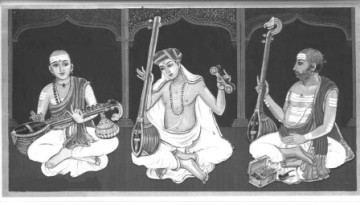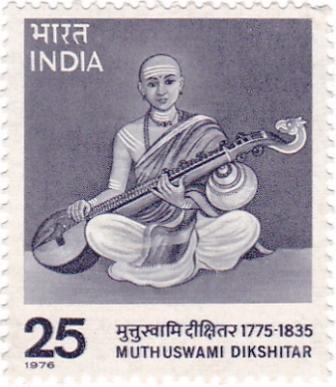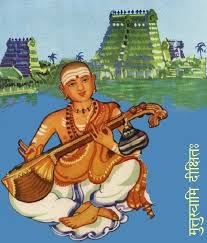Introduction to Shri Muthuswami Dikshitar
Muttuswamy Dikshitar, the youngest among the trinity of carnatic music, was a Vainika
(a Veena exponent), composer par excellence, Saadhaka and a Srividya Upasaka.
Dikshitar, a versatile composer, was adept at various distinctive forms of music and
possessed immaculate linguistic abilities. The plethora of gems that he has created have
acquired an important place in the Carnatic music repertoire.
Early Life of Muthuswami Dikshitar
Muttuswamy Dikshitar was born as the eldest son to Ramaswami Dikshitar and
Bhageerathamma in 1775, in Tiruvarur, Tamil Nadu. Muttuswamy Dikshitar had two
brothers, namely, Chinnayya and Baluswami Dikshitar, and a sister, Balamba. Young
Muddayya started training under his father, who was a prolific scholar in subjects like
Vedas and Astrology, and was also the creator of the Raga Hamsadhwani in Carnatic
music.
Role of Sri Chidambaranatha Yogi in Dikshitar’s life
Guru Sri Chidambaranatha Yogi played a pivotal role in Muttuswamy Dikshitar’s life as
a composer and musician. As per the Guru’s wish, Dikshitar travelled to Varanasi with
the Yogi, who broadened his perspectives about various aspects of music. The eight long
years of study with him,which proved to be the most fruitful years of his life, introduced
Dikshitar to Tantra, Advaita Siddhanta and Sri Vidya Upasana. This period of his life in
Kasi gave him an opportunity to absorb the city’s musical atmosphere and travel to
several holy places in the north such as Badrinath and Kedarnath. Finally, his travels
culminated in compositions on the presiding deities . He was also introduced to the
nuances of Dhrupad genre of music, the compositions of Tulsi Ramayana and many
other poets like Surdas and Meera. Dikshitar was greatly impressed by the ancient
Dhrupad form of singing and this influence can be seen in his compositions where he
adapted the Hindustani ragas to Carnatic music and gave them a new shape.
Sri Chidambaranatha Yogi initiated Deeksha to Dikshitar- “Sri Chidananda Nathoham
Iti” , during his stay at Kasi. Sri nathadi guruguho jayati is said to be his first
composition using this name.
Legend has it that after his stay in Kasi, Dikshitar travelled down South. As he was
passing through Tiruttani, he encountered an old man who put a sweet candy in
Dikshitar’s mouth. Soon after this incident, Dikshitar is said to have composed his first
song Sri nathadi Guruguho Jayati in the Raga Mayamalavagowla. It is said that Lord
Muruga, the presiding deity of Tiruttani, visited in the guise of an old man and blessed
Dikshitar. This proved to be a turning point in his life.

The Music of Muttuswamy Dikshitar
Dikshitar’s compositions can be studied and analysed under various categories, some of
which are listed below.
Mudra
Muttuswamy Dikshitar used the itaranama mudra or signature, Guruguha, as opposed
to Sri Tyagaraja, who used swanama mudra Tyagaraja or Shyama Shastry’s Shyama
krishna in most of their compositions
Shabdaarnava
Dikshitar, the master of wordplay that he was, has embellished his works with prasas or
alliteration, swarasahitya, swaraksharas, gopucha yati and srotovaha yati among many
others. He has creatively interspersed the raga mudra without disconnecting it from the
flow of the composition.
Bhaasharnava
Dikshitar was well versed in many languages, but composed extensively in scholarly
Sanskrit language.
Ragarnava
Dikshitar is credited with using rare ragas like Andali and he has composed with the
same ease in common ragas like Todi or Dheerashankarabharanam.
Dikshitar followed the Asampoorna mela paddhati, which is the 72 melakarta scheme of
raga classification and gave life and shape to nearly 200 ragas. It is surprising to note
that Dikshitar has not used the very popular Raga Kharaharapriya for any of his
compositions.
The influence of the north has had a profound impact on his style of composing, be it in
the adaptation of Hindustani ragas like Dwijavanti, Hamirkalyani, Yamunakalyani and
giving them the Carnatic flavour through his compositions, or in the choice of adding
samashti charanams, similar to the Dhrupad form. He captures the essence of ragas
through the vainika style, laying greater emphasis on the gamakas or oscillation.
Talarnava
It becomes imperative for a student of music to understand the intention of a composer
when he composes in a specific format or tala and it is our moral responsibility to
adhere to and respect the composer’s work. Dikshitar has extensively used Suladi talas
in his compositions, which now are rendered using the chapu tala format to suit the
concert structure. Dikshitar has used variants of the Suladi Sapta Talas, without making
them appear complex, thereby preserving the aesthetics of the raga and lyrics.
Vaakprakaara
Muttuswamy Dikshitar had a majestic style of his own. His kritis are often subjects of
research in order to understand the intricacies involved. The vainika style is reflected in
each of his scholarly pieces.
The madhyamakala sahitya after the long drawn out parts of the dhatu are a welcome
change and immediately showcase a different flavour of the raga.
Dikshitar has experimented successfully with various kala pramanams, be it chowka
kala pramanam like Akhilandeshwari (Jujavanti/Dwijavanti) or madhyama kala
pramanam like balambike in Raga Manoranjani, each having its own beauty and
fervour.
His compositions are generally attributed to narikela rasa, where the outer shell of the
coconut is hard and the inner fruit is soft, which shows that his compositions are
complex to learn, yet elegant and high in aesthetics. Kritis like Chetah Sri (Dwijavanti),
Balagopala (Bhairavi), Meenakshi Memudam (Gamakakriya) are a few illustrations of
this rasa.
Vaggeya Vaibhava
Perhaps Dikshitar is one of the very few composers who can be credited with a variety of
kritis, be it the various themes or the presiding deities they are based on. Some of them
are listed below:
- Abhayamba Navavarnas
- Kamalamba Navavarnas
- Neelotpalamba Kritis
- Navagraha Kritis ( on the nine planets)
- Pancha linga kritis
- Notuswarams
- Ragamalikas
- Guru Vibhakti Kritis
Tryst with Western Music
Muttuswamy Dikshitar was introduced to English Band music when he visited the
colonnial settlement at Fort St George in Madras. Inspired by this, he composed around
40 short western folk tunes called Notuswarams, that can be loosely attributed to being
in Raga Shankarabharanam.
While, inspired by the English Band music, Muttuswamy Dikshitar composed the
Notuswarams, Baluswami Dikshitar sought Violin lessons from a European teacher and
adapted the Violin to Carnatic music, which has now become an indispensable part of
the concert platform.
Varshaya Varshaya
There is an interesting incident in the life of Dikshitar. Once, when he was on his way to
Ettayapuram and had to pass across a barren tract of land that had not seen rains for
many years,he immediately composed the kriti Anandamruthavarshini in the raga
Amruthavarshini. Surprisingly, the utterance of the words varshaya, varshaya
meaning come down, come down, resulted in a heavy downpour. Later, to stop the
torrential rains, he replaced the words varshaya varshaya with Sthambaye Sthmbaye ,
stop,stop, and the rains subsided gradually.
Shishyaratna
At Thanjavur, Dikshitar accepted students interested in learning music and he has the
credit of training the famed Tanjore Quartet, Chinnaiah, Ponnayya, Sivanandam and
Vadivelu. These brothers, later, went on to become court musicians who composed
several padams and Thillanas used in Bharatanatyam.

Hamsa Geeta - The SwanSong
In the year 1835, at Ettayapuram, he could foresee the end of mortal life. After
performing his routine worship to Devi, he requested his disciples to sing the
composition on Devi, Meenakshi Memudam in Raga Gamakakriya. When the line
Meenalochani Pasha mochani was rendered, Muthuswami Dikshitar uttered “Shive
pahi, Shive pahi” and like a true yogi, he is said to have breathed his last.
Dikshitar lives on through his compositions. Subbarama Dikshitar, the nephew of
Dikshitar, has played a very important role in preserving Muttuswamy Dikshitar’s works
through his book Sampradaya Pradarshini. This compilation is said to be the most
authentic and go-to reference for any work of Dikshitar’s.


